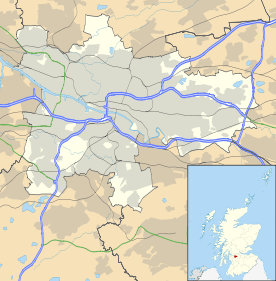Dennistoun
Coordinates: 55°51′39″N 4°12′58″W / 55.8609°N 4.2161°W
Dennistoun is a district of the city of Glasgow, Scotland. It is situated north of the River Clyde in the east end of the city. It is made up of a number of smaller districts - Milnbank to the north, 'The Drives' in the centre of the area and Bellgrove below Duke Street to the south. In a 2004 census the area had a population of roughly 10,530. Although predominantly tenemental, the Victorian villas and terraces to the west (towards the city centre) illustrate part of Alexander Dennistoun's original plan for the whole area.
Unable to attract the middle-class residents intended by its original developers, it established itself as a respectable working class area for families. After the Second World War, the area's Victorian tenements were refurbished and extended rather than replaced with high-rise modernist blocks as in other working-class districts such as neighbouring Calton and Parkhead, and this, coupled with proximity to the city centre and Caledonian and Strathclyde universities, has contributed to its gentrification in recent years; many of its residents are now students and young professionals.
Transport
The district is served by Alexandra Parade, Duke Street and Bellgrove railway stations (all on the North Clyde Line) as well as numerous bus routes, offering commuter services to the city centre and on toward the western suburbs.
Amenities
Dennistoun benefits from a large Victorian park, Alexandra Park, which is bounded predominately by the M8/M80, Cumbernauld Rd & Provan Road. The Park takes its name from Princess Alexandra of Denmark, the wife of the future King Edward VII of the United Kingdom, who officially opened the Park in 1870. The park was established in 1866 when the City Improvement Trustees purchased Alexandra Park from Mr Walter Stewart of Haghill under special powers conferred upon them by legislation. Mr Alexander Dennistoun, the proprietor of the adjoining estate of Golfhill, gave 5 acres (20,000 m2) of land to the City Improvement Trustees. This ground was situated near the south-west corner adjacent to Alexandra Parade, which now forms the principal pedestrian entrance.
The park is home to a 40-foot (12 m) cast-iron Walter MacFarlane Saracen Fountain which was given to the City after the 1901 International Exhibition and remained in Kelvingrove Park for 12 years after the exhibition. In 1914 Glasgow Corporation took the decision to re-site this magnificent piece of industrial architecture to its present location. The fountain was restored to its former glory in 2000.
Whitehill Pool was opened in 1978 and is shared with the neighbouring school It provides a 25m pool, small teaching pool, fitness suite, health suite and spectator gallery with over 200 seats and is situated on Onslow Drive
Dennistoun also has one of Glasgow's original Carnegie libraries, deftly designed in the Edwardian Baroque style by James Robert Rhind.
Market Gallery, an artist-run contemporary art gallery, is located on Duke Street and spread over three shop units. WASPS artists' studios, a charity providing affordable studio space to support up to 750 artists, is located on Hanson Street.
The community is well served by two shopping areas on Duke Street and Alexandra Parade. There are also two supermarkets and two long-established Italian delicatessens. Although the fortunes of local businesses have varied over the years, more recently a clear upturn in the number of independent retail and leisure premises has been apparent.[1]
Religion
The area has a proliferation of churches, including the Church of Scotland, Roman Catholic (including Our Lady of Good Counsel, designed by noted Modern architects Gillespie, Kidd & Coia), Baptist, Salvation Army, independent Evangelical churches, Plymouth Brethren, Charismatic, one Scottish Episcopal Church and a Christadelphian presence.[2]
In 2007 it was decided that the two Church of Scotland congregations, Dennistoun Blackfriars and Dennistoun Central churches would unite to form Dennistoun New parish church. This followed long vacancies dating from 2000 (Dennistoun Blackfriars) and 2004 (Dennistoun Central).
Schools
There are three main primary schools in the greater Dennistoun area (excluding Haghill): Golfhill Primary, originally located on Circus Drive but now housed within the main building of Whitehill Secondary School (the original school building still stands, however remains derelict due to health and safety reasons. The school was built upon the site of a filled quarry and this has led to significant structural problems), Alexandra Parade Primary School located on Armadale Street and St Denis' RC Primary School on Meadowpark Street. The only Secondary School in the area is Whitehill Secondary School which is majority fed by pupils from Golfhill Primary, Alexandra Parade Primary and Haghill Primary. As it is a non-denominational school, most of the pupils from St Denis' go to St Mungo's Academy located on Crownpoint Road.
Famous current and former residents
- Jack House Journalist and author
- Bill Paterson Actor
- Ella Logan Broadway actress and singer
- Alex Kapranos and Bob Hardy of Franz Ferdinand
- Deborah Kerr, leading Hollywood actress of the 1950s.
- Lulu
- Charles Rennie Mackintosh Architect, designer and artist
- Hugh Brown (British politician) Labour Party M.P who earned the Red Clydesider title.
- Rikki Fulton
- Gordon Ramsay
- Frank Kelly from the comedy series Father Ted
- Dorothy Paul
- Bruce Morton stand-up comedian
- Alex McLeish football player and manager
- William Miller, author of Wee Willie Winkie
- Stuart Cosgrove
- Alex Rae football player and manager
- Alan McManus snooker player
- Jon Campbell, producer of The Time Frequency.
- Ford Kiernan, Comedian
- Jim Tolmie football player
External links
- Dennistoun Online - Local community forum and news pages.
- Dennistoun Community Council - group responsible for ascertaining, coordinating and expressing the views of the wider community.
- Dennistoun Conservation Society - Local conservation society.
References
- ↑ "Evening Times: The New Eastenders, Publication date 06/03/08". Retrieved 2007-03-12.
- ↑ "Glasgow Central Christadelphians". Retrieved 2007-05-29.
